Cloud computing was already growing fast before 2020—but the shift to remote work sent adoption into overdrive.
Even as some teams return to the office or settle into hybrid setups, cloud growth hasn’t slowed down.
Today, it’s not just about remote access.
The cloud now powers AI, machine learning, IoT, and advanced data analytics, making it essential to how businesses innovate and scale.
Below are the latest cloud computing stats that show how far it’s come—and where it’s going next.
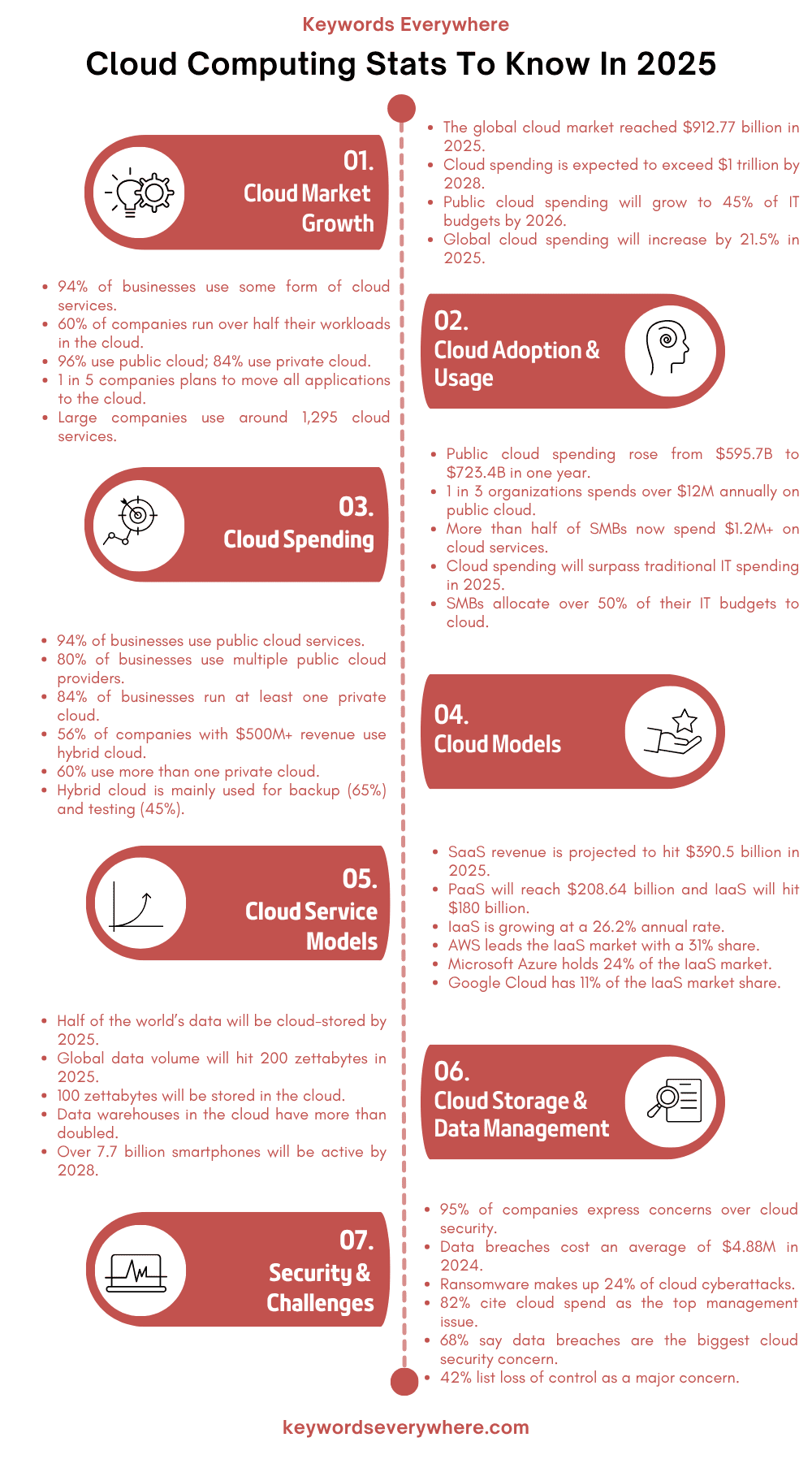
Top Cloud Computing Stats
Cloud computing has become the basis of how businesses run today, with over 94% of enterprises using some form of cloud service in 2025 and global cloud spending surpassing $675 billion this year alone.
These cloud computing stats tell a powerful story about just how far cloud adoption has come:
1. The global cloud computing market grew fast—from $156.4 billion in 2020 to a massive $912.77 billion in 2025.
2. At this pace, the cloud market is expected to go beyond $1 trillion by 2028.
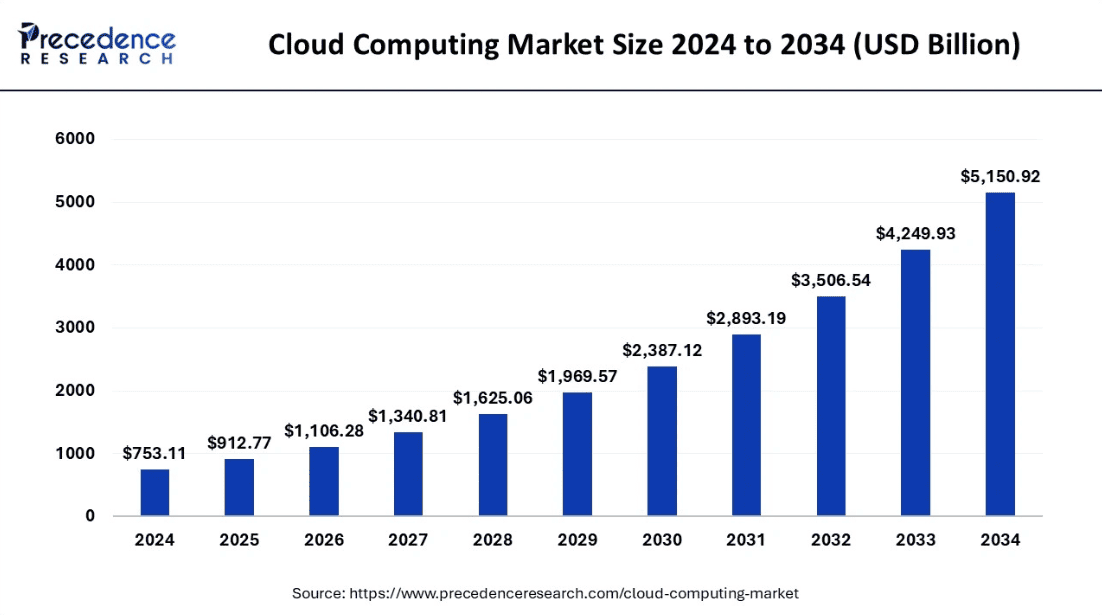
Cloud computing market size
3. Moving your business to the public cloud can lower your overall tech costs by up to 40%.
4. For many companies, updating apps and connecting them to cloud services is one of the biggest goals over the next three years.
5. Amazon Web Services is still leading the way in cloud services, holding 32% of the market.
6. Almost all companies (96%) use public cloud services, and 84% also use private cloud solutions.
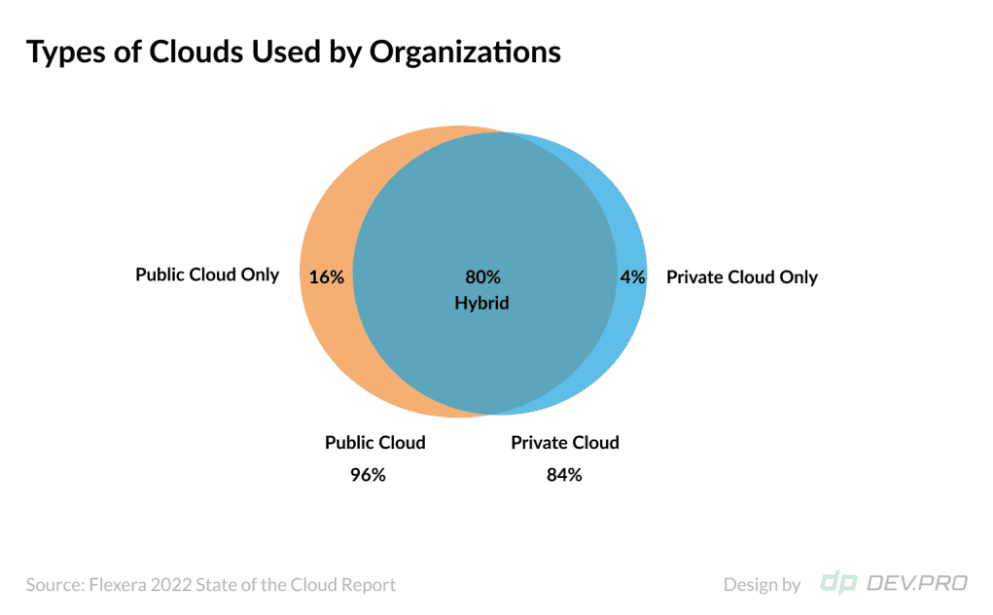
Types of clouds used by organizations
7. The biggest headache for cloud managers is keeping cloud spending under control—82% say this is their top issue.
8. A survey found that 94% of businesses use the cloud in some way, and 83% are juggling more than one cloud provider.
9. The biggest cloud security worry is data breaches, with 68% of companies listing it as their main concern.
10. According to Keywords Everywhere, “Cloud computing” and related terms get searched a lot every month, which shows that more and more businesses are interested in moving to the cloud.

Global Cloud Market Growth Stats
The global cloud computing market is not just growing—it’s accelerating faster than most tech sectors, reaching a market value of $912 billion in 2025, driven largely by enterprise demand, digital transformation, and AI workloads.
With a CAGR of more than 20%, this expansion reflects how cloud infrastructure and services are now seen as essential components of business continuity, innovation, and scalability across nearly every industry.
Below are the cloud computing stats that highlight how fast the global market is growing and where it’s headed next.
11. The global cloud computing market is about to reach $912.77 billion in 2025, showing just how fast it’s growing.
12. From 2025 to 2034, the cloud market is set to grow by over 21% every year, which means it’s not slowing down anytime soon.
13. The U.S. cloud computing market was valued at $431.76 billion in 2024, and it’s expected to grow to nearly $3 trillion by 2034.
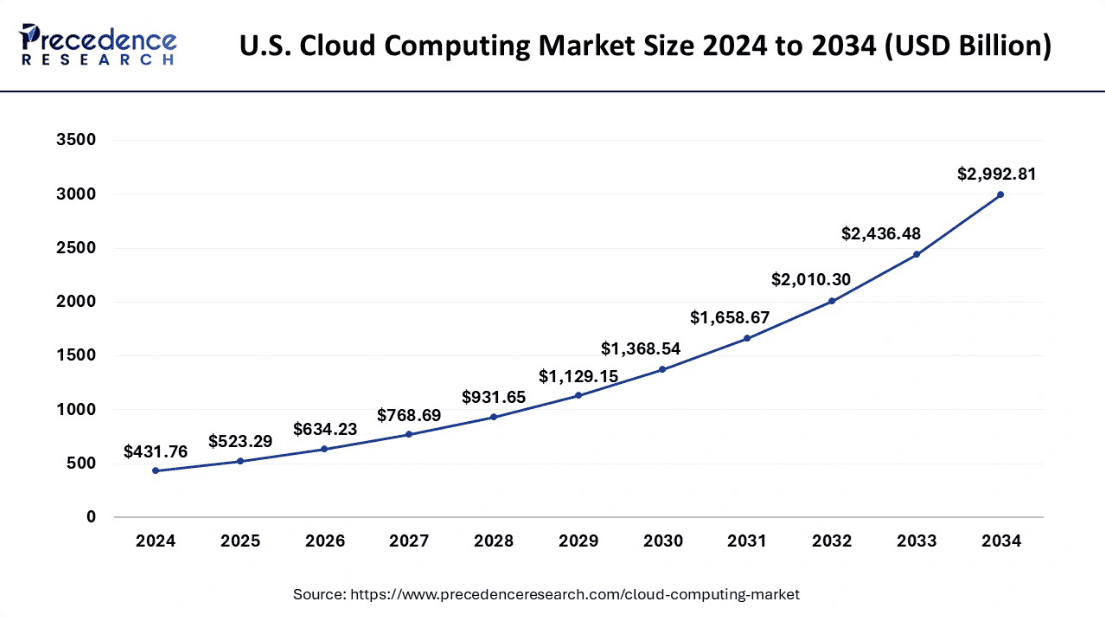
US cloud computing market size
14. From 2025 to 2034, the market is forecasted to grow at a robust pace of over 21% annually.
15. Businesses around the world are expected to spend $723.4 billion on cloud services in 2025 alone.
16. Compared to 2024, cloud spending is expected to increase by 21.5% in 2025, indicating that more companies are investing in this area.
17. By 2027, banks, software companies, and telecom businesses will spend a total of $326 billion on public cloud services.
18. Public cloud spending will rise fast—from under 17% of business IT budgets in 2021 to more than 45% by 2026.
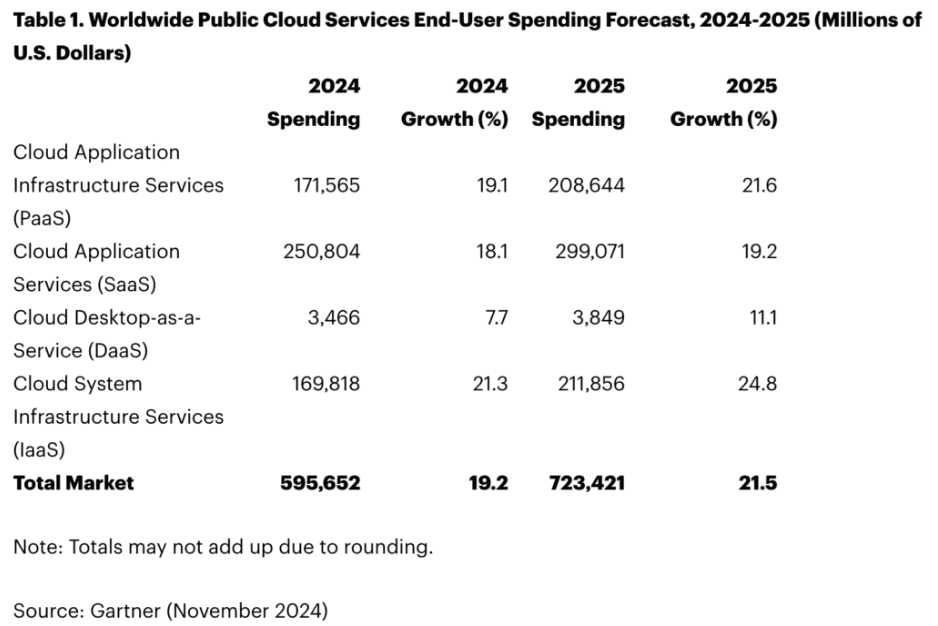
Public cloud services end-user spending forecast
Cloud Adoption and Usage Stats
Businesses of all sizes are adopting the cloud not just for storage but also for running apps, scaling resources, and supporting remote workforces, showing how cloud usage has gone from a trend to a baseline expectation across the global economy.
Here are the cloud computing stats that reveal how widespread adoption has become and how companies are putting the cloud to work.
19. Around two-thirds of businesses now use public cloud services, while 45% still use private clouds, and 55% continue to rely on older on-premises systems.
20. Nearly half of companies plan to move at least half their apps to the cloud within the next year, and 1 in 5 aim to move everything.
21. Right now, 60% of businesses run more than half their workloads in the cloud—a big jump from 39% in 2022.
22. Among companies with over 1,000 employees, more than 94% are using the cloud for a major portion of their work.
23. About 44% of traditional small businesses use cloud hosting or infrastructure, while usage jumps to 66% for small tech firms and 74% for large enterprises.
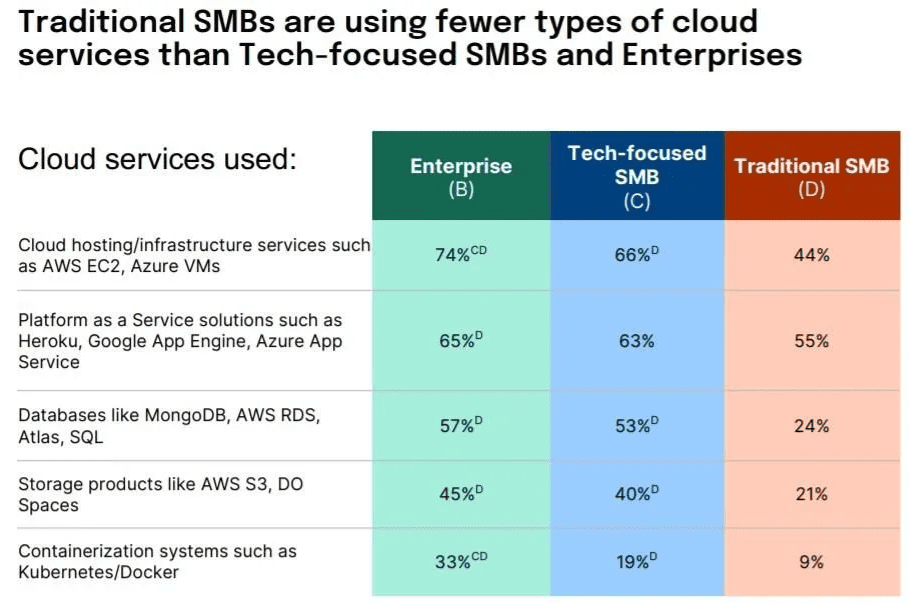
Traditional SMBs are using fewer types of cloud services
24. The U.S. and Western Europe lead the way in cloud adoption, together making up 82% of the world’s cloud computing market.
25. Cloud use is also picking up speed in Sub-Saharan Africa and Central and Eastern Europe, according to recent Oracle findings.
26. Right now, 30% of companies in those regions are using cloud services, and many larger companies are planning or exploring cloud strategies.
27. Personal cloud tools like Google Drive, Dropbox, and iCloud have more than doubled in users—growing from 1.1 billion in 2014 to 2.3 billion today.
28. On average, a single employee uses 36 cloud-based tools each day, while the typical large company relies on about 1,295 cloud services.
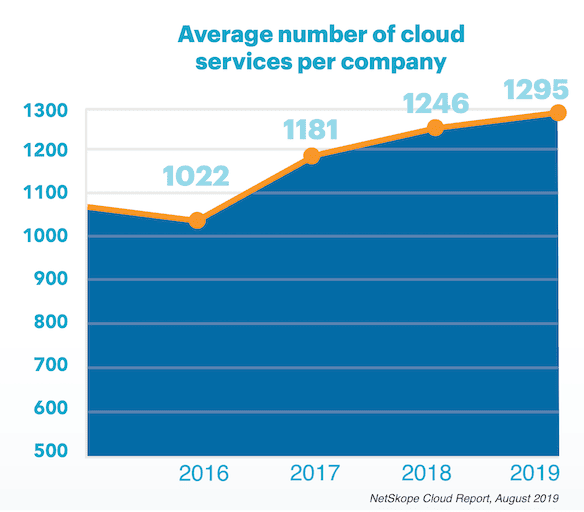
Average number of cloud services per company
Cloud Spending Stats
Cloud spending has hit record highs in 2025, with enterprises allocating an average of 32% of their total IT budgets to cloud technologies and services, often outpacing spending on traditional IT infrastructure.
Below are the cloud computing stats that show where the money is going in today’s cloud landscape.
29. In 2025, small and mid-sized businesses are expected to spend more than half of their tech budgets on cloud services, showing just how important the cloud has become.
30. Global spending on public cloud services is about to hit $723.4 billion in 2025, up from $595.7 billion in 2024, thanks to the rising use of AI and hybrid cloud setups.
31. About 1 in 3 organizations are spending over $12 million each year on public cloud services in 2025.
32. Over half of small and medium businesses are now spending more than $1.2 million on the cloud each year, a sharp rise from just 38% doing so two years ago.
33. Gartner reports that traditional IT still makes up most tech spending, but by 2025, cloud spending will finally pull ahead and become a bigger investment.

Cloud shift worldwide, 2019-2025
Public, Private, Hybrid & Multicloud Stats
The cloud isn’t one-size-fits-all.
While public cloud still dominates with over 50% market share, private cloud use continues to grow among industries with strict compliance needs, and more companies are spreading their workloads across multiple providers to balance cost, performance, and security.
Here are the cloud computing stats that break down the different types of cloud models companies are choosing and why.
34. A Flexera survey found that 94% of companies use public cloud services in some way, making it nearly universal across industries.
35. Amazon Web Services leads the public cloud market with 32% of the share, followed by Microsoft Azure at 23%.
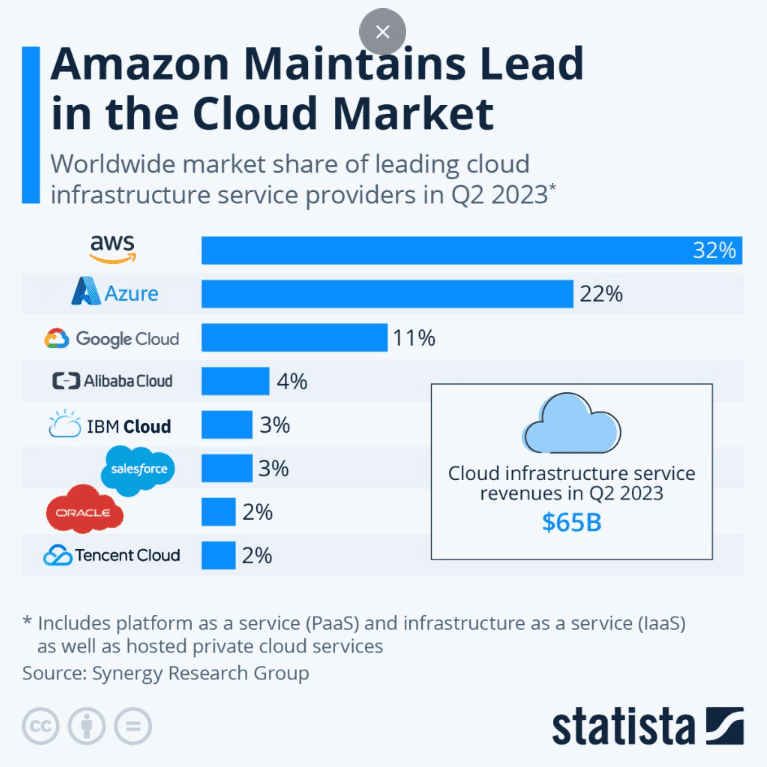
Amazon leads the cloud market
36. The most popular reasons companies use the public cloud are for hosting apps (66%), websites (62%), and storing or backing up data (62%).
37. Businesses that switch to the public cloud can save anywhere from 15% to 50% compared to sticking with traditional on-site systems.
38. Private cloud revenue is expected to grow big, reaching $528.36 billion by 2029.
39. About 84% of businesses use at least one private cloud, and they run roughly 32% of their workloads in these environments.
40. The biggest perks of private cloud use include stronger security and compliance (68%), better performance (59%), and more control over resources (52%).

Top benefits of private cloud adoption
41. Nearly 80% of businesses use more than one public cloud, and 60% say they also use multiple private clouds to meet their needs.
42. Among large companies earning over $500 million, 56% rely on a hybrid cloud setup that mixes public and private services.
43. A hybrid cloud is commonly used for backing up and recovering data (65%), analyzing big data (48%), and developing or testing apps (45%).
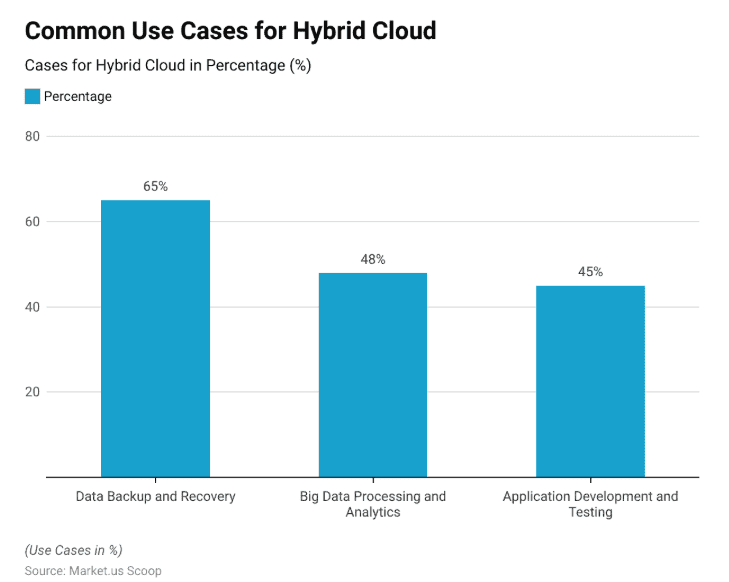
Common use cases for hybrid cloud
44. The biggest roadblocks to hybrid cloud use are security worries (62%), lack of skilled cloud experts (47%), and trouble connecting cloud and in-house systems (47%).
45. Most businesses now use either hybrid cloud setups (39%) or multicloud strategies (33%) to stay flexible, grow faster, and keep operations running smoothly.
Cloud Service Models: IaaS, PaaS, SaaS Stats
Each cloud service model—Infrastructure as a Service (IaaS), Platform as a Service (PaaS), and Software as a Service (SaaS)—is growing rapidly, but SaaS continues to lead the pack in 2025, making up over 45% of total cloud spending.
Below are the cloud computing stats that explain how each cloud model is being used and where growth is happening the fastest.
46. The cloud market hit $330 billion in 2024, growing by $60 billion in just one year—thanks in large part to generative AI, which powered about half of that growth.
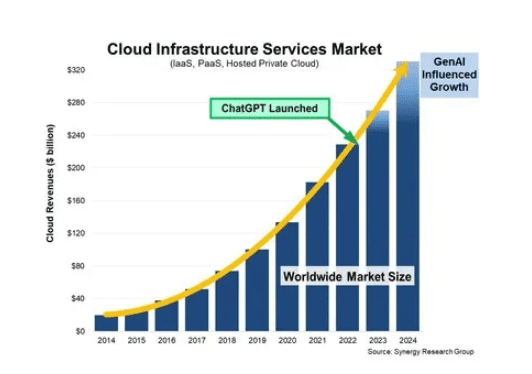
Cloud infrastructure services market
47. Software as a Service (SaaS) is still the top cloud service, with revenue expected to reach around $390.5 billion—much more than Platform as a Service (PaaS) at $208.64 billion or Infrastructure as a Service (IaaS) at $180 billion.
48. IaaS is growing fast, with a yearly growth rate of 26.2% through 2025, boosted by the rise of AI, big data, and the need for remote work tools.
49. Amazon Web Services leads the IaaS market with 31%, Microsoft Azure follows at 24%, and Google Cloud holds third place with an 11% global share in 2024.
Cloud Computing by Industry
Different industries are embracing cloud technologies at various speeds.
Sectors like healthcare, finance, manufacturing, and retail are all reporting adoption rates above 70%.
But what about other industries? How are they using the cloud?
Here are the cloud computing stats showing how key industries are using the cloud to solve unique business challenges.
50. In healthcare, 48% of organizations use the cloud to store data, and 41% rely on it for backup and disaster recovery.
51. The top reasons healthcare providers are moving to the cloud are scalability and flexibility (61%), cost savings (58%), and better data storage options (52%).
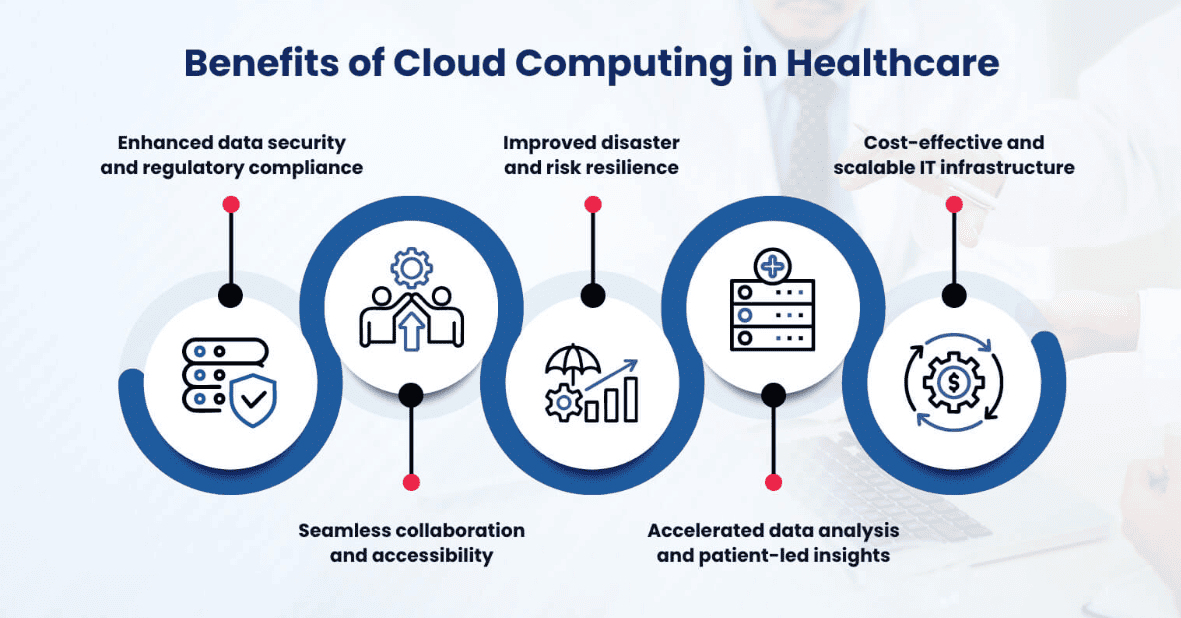
Benefits of cloud computing in healthcare
52. A strong 80% of healthcare IT leaders believe cloud computing is the safest way to handle sensitive patient data.
53. In finance, cloud adoption was expected to hit 70% by 2023 as more institutions turned to digital solutions.
54. For 80% of financial companies, the biggest reasons to adopt cloud services are stronger security and easier compliance with regulations.
55. About 82% of financial firms use a hybrid cloud setup, blending private and public cloud environments for better flexibility.
56. In retail, 80% of businesses are already using or planning to use the cloud for their day-to-day operations.
57. Around 83% of retailers say the cloud has made their IT systems more flexible and easier to scale.
58. Nearly 3 out of 4 retailers (73%) use cloud-based analytics to understand customer behavior and improve decisions.
59. 58% of retailers have chosen a hybrid cloud approach to mix private and public cloud options for better performance.

Advantages of using hybrid cloud
60. In manufacturing, 94% of companies are either using or thinking about using cloud-based ERP systems.
61. About 80% of manufacturers have already added cloud solutions or plan to do so soon.
62. The use of cloud-based tools in manufacturing is expected to rise by 47% over the next three years.
Cloud Providers Market Share Stats
In 2025, the cloud provider landscape is still led by the big three—Amazon Web Services (AWS), Microsoft Azure, and Google Cloud—who together hold more than 65% of the global market.
However, newer players and regional providers are starting to carve out space, especially in areas with strict data sovereignty rules.
Below are the cloud computing stats that show which providers are leading the market and how the competition is shifting.
63. Amazon Web Services (AWS) rules the public cloud market with 30% of the global share, making it the biggest player out there.
64. Microsoft Azure comes in second with a 21% share, while Google Cloud Platform (GCP) holds 12% of the market.
65. Infrastructure cloud services are set to grow by 25% in 2025, showing how fast businesses are expanding their cloud systems.
66. Platform services are also growing strong, with a projected 22% increase in 2025 as companies invest more in development tools and cloud environments.
67. The hybrid cloud market is forecasted to grow to $128.01 billion by 2025 as more businesses mix private and public clouds for flexibility.
68. Edge computing, which brings data processing closer to where it’s needed, is set to reach $15.7 billion by 2025.

Edge computing market, by region
Cloud Storage and Data Management Stats
Cloud storage use has surged as more companies move everything from backups to real-time databases into scalable storage platforms.
Object storage is growing fast, especially for AI training and big data projects, while data management tools are now essential to help businesses deal with the rising costs and complexity of storing data at scale.
Here are the cloud computing stats that explore how companies are storing and managing massive volumes of data in the cloud.
69. By 2025, half of all data in the world will be stored in the cloud, up from just 25% in 2015—showing how fast cloud storage is taking over.
70. The total amount of data worldwide is expected to hit a massive 200 zettabytes by 2025—that’s a trillion gigabytes.
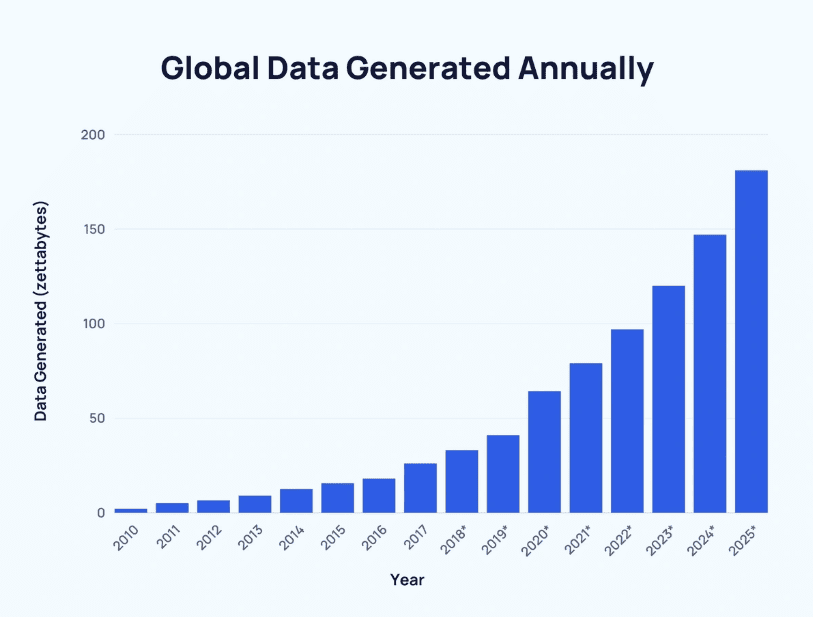
Data generated annually
71. Out of that, 100 zettabytes will be stored in the cloud alone, proving just how important cloud systems have become.
72. By 2028, there will be over 7.7 billion smartphones around the world, driving more demand for cloud storage and data access on the go.
73. Cloud-based data warehouses have more than doubled in recent years as more companies move away from traditional storage solutions.
Cloud Security and Compliance Stats
Security remains one of the top concerns in 2025, with more than 75% of IT leaders saying it’s their biggest challenge in the cloud, even as cloud security services grow more advanced.
Here are the cloud computing stats that highlight ongoing security concerns and how businesses are working to stay compliant.
74. Around 95% of companies are at least somewhat worried about cloud security.
75. The average cost of a data breach rose to $4.88 million in 2024, with healthcare being hit the hardest—losing over $10.9 million per breach on average.

Average cost of a data breach, by industry
76. In 2025, ransomware makes up 24% of all cyberattacks, and phishing is still the most common way in, often using fake emails from big names like Microsoft, Google, or Apple.
77. About 73% of companies say cloud technology has made their operations more complex, and 70% of CIOs feel they’ve lost some control over their systems.
78. Unplanned IT downtime now costs businesses an average of $14,056 every minute, and for large companies, that number jumps to $23,750 a minute.
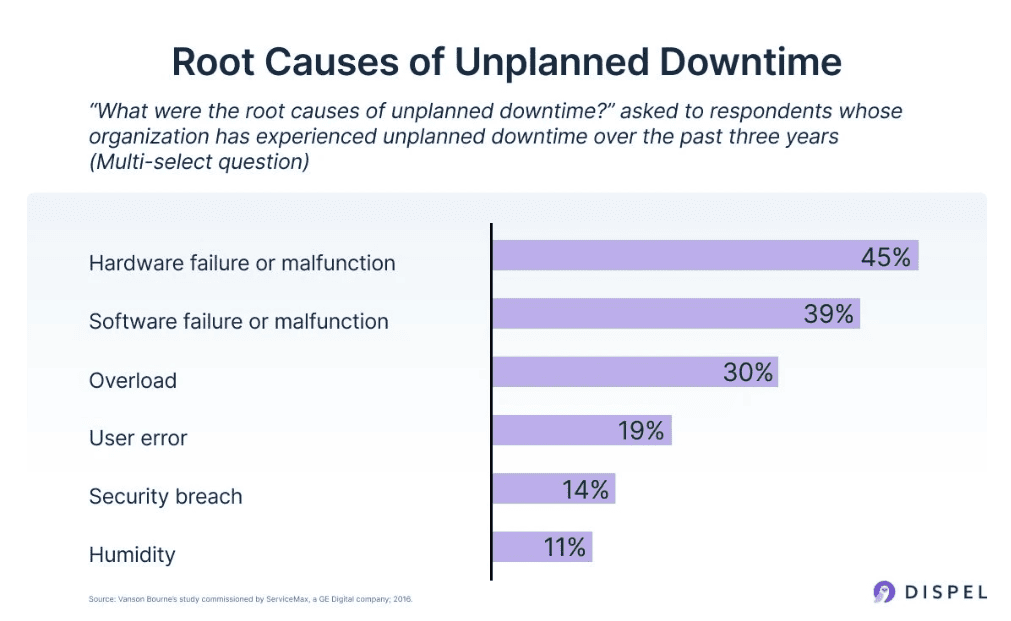
Causes of unplanned downtime
79. 77% of organizations believe using the cloud has helped them meet industry compliance rules and standards.
80. More than half of businesses (54%) say that compliance is the main reason they moved to the cloud in the first place.
81. The global cloud compliance market is expected to hit $6.12 billion by 2025 as more businesses focus on meeting regulations in the cloud.
Cloud Challenges and Concerns Stats
Even as adoption grows, businesses are facing serious cloud-related challenges in 2025, including spiraling costs, performance bottlenecks, and the complexity of managing multi-cloud environments.
Below are the cloud computing stats that show the real struggles companies face in maintaining and optimizing their cloud environments.
82. In the State of the Cloud Report, both large companies and small businesses said the biggest reasons they haven’t fully embraced the cloud yet are high costs and security concerns.
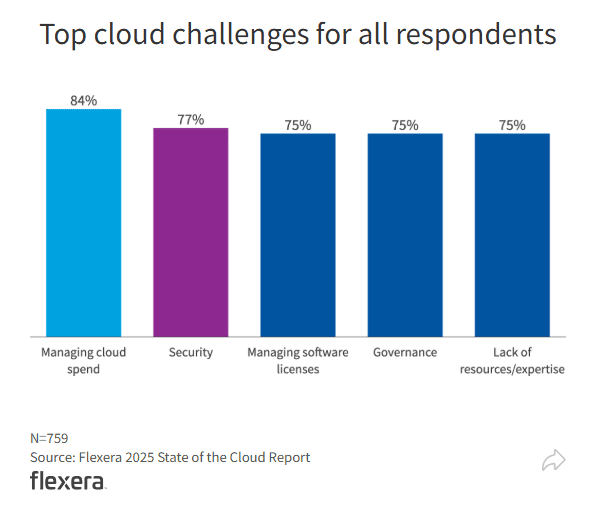
Top cloud challenges
83. According to Fortinet’s Cybersecurity Insiders Report, the biggest roadblocks to cloud adoption include poor visibility (49%), high costs (43%), lack of control (42%), limited staff or skills (39%), and security gaps (22%).
84. About 68% of SaaS companies offer discounts in fewer than one out of four deals, showing how pricing remains a challenge in cloud-based software.
85. PwC’s US Cloud Business Survey found that many companies struggle with cloud adoption due to lack of integration with current systems, not enough skilled talent, and a general lack of cloud expertise.
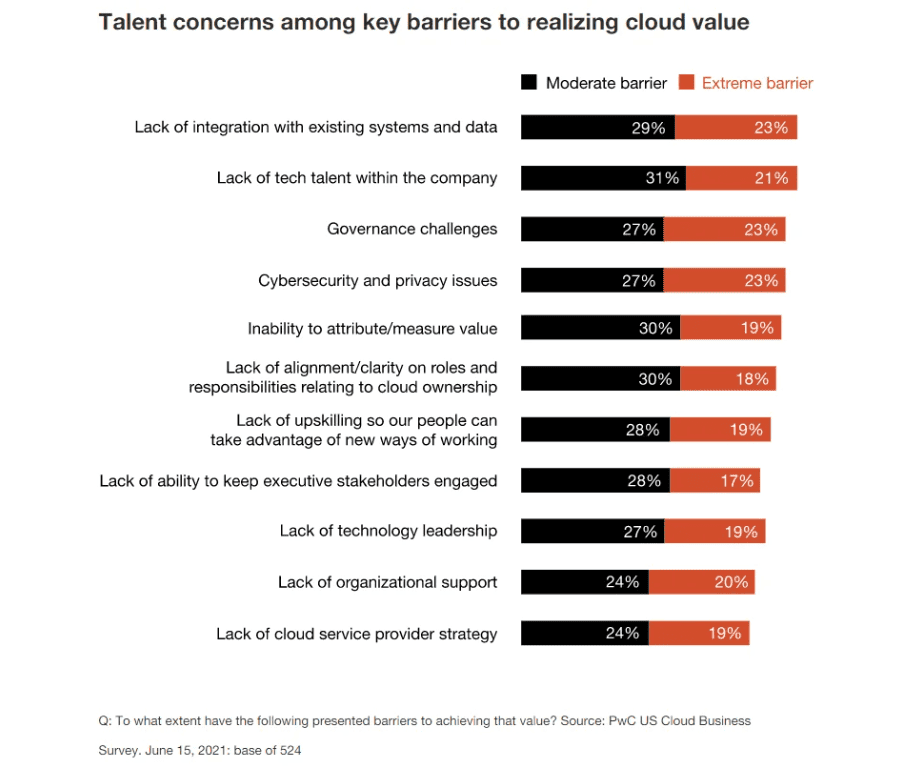
Top challenges to adopting cloud computing
The Future of Cloud Computing
Looking ahead, cloud computing is expected to evolve even more rapidly, with edge computing, serverless architectures, and quantum cloud services predicted to reshape the market by 2030.
Gartner forecasts that by 2028, over 90% of new digital initiatives will be cloud-native, showing how deeply the cloud is becoming embedded in future business and technology strategies.
Here are the cloud computing stats that give a glimpse of where the cloud is headed and what businesses should prepare for.
86. By 2025, 75% of enterprise data will be created and processed outside traditional data centers or the cloud, happening instead at the “edge” closer to where the data is generated.
87. IT could be responsible for 8% of the world’s greenhouse gas emissions by 2025, though the Green Electronics Council says its green tech efforts have already saved nearly 400 million megawatt-hours.
88. The global remote desktop software market is set to more than double—rising from $2.2 billion in 2022 to over $5.5 billion by 2025, thanks to remote work and hybrid teams.
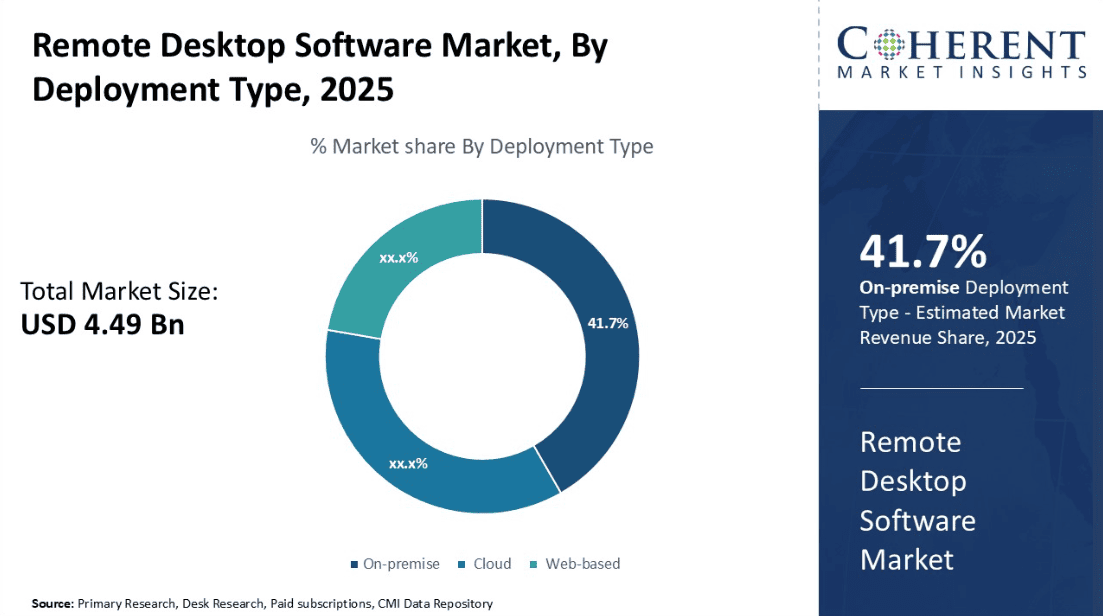
Remote desktop software market
89. Demand for cloud computing skills is forecasted to rise by 25% in 2025 as more companies rely on the cloud for everyday operations.
90. By 2025, 70% of IT professionals are expected to have certifications related to cloud technology.
91. At the same time, 60% of businesses will likely struggle to find enough qualified cloud talent.
Conclusion
Cloud computing is now the backbone of modern digital operations. Its ability to scale quickly, reduce costs, and support innovation has made it very important for businesses of every size.
From improved collaboration to stronger security and real-time data access, the cloud is transforming how we work and compete.
As demand grows and technology advances, cloud computing will only become more central to how industries evolve and succeed in the future.


